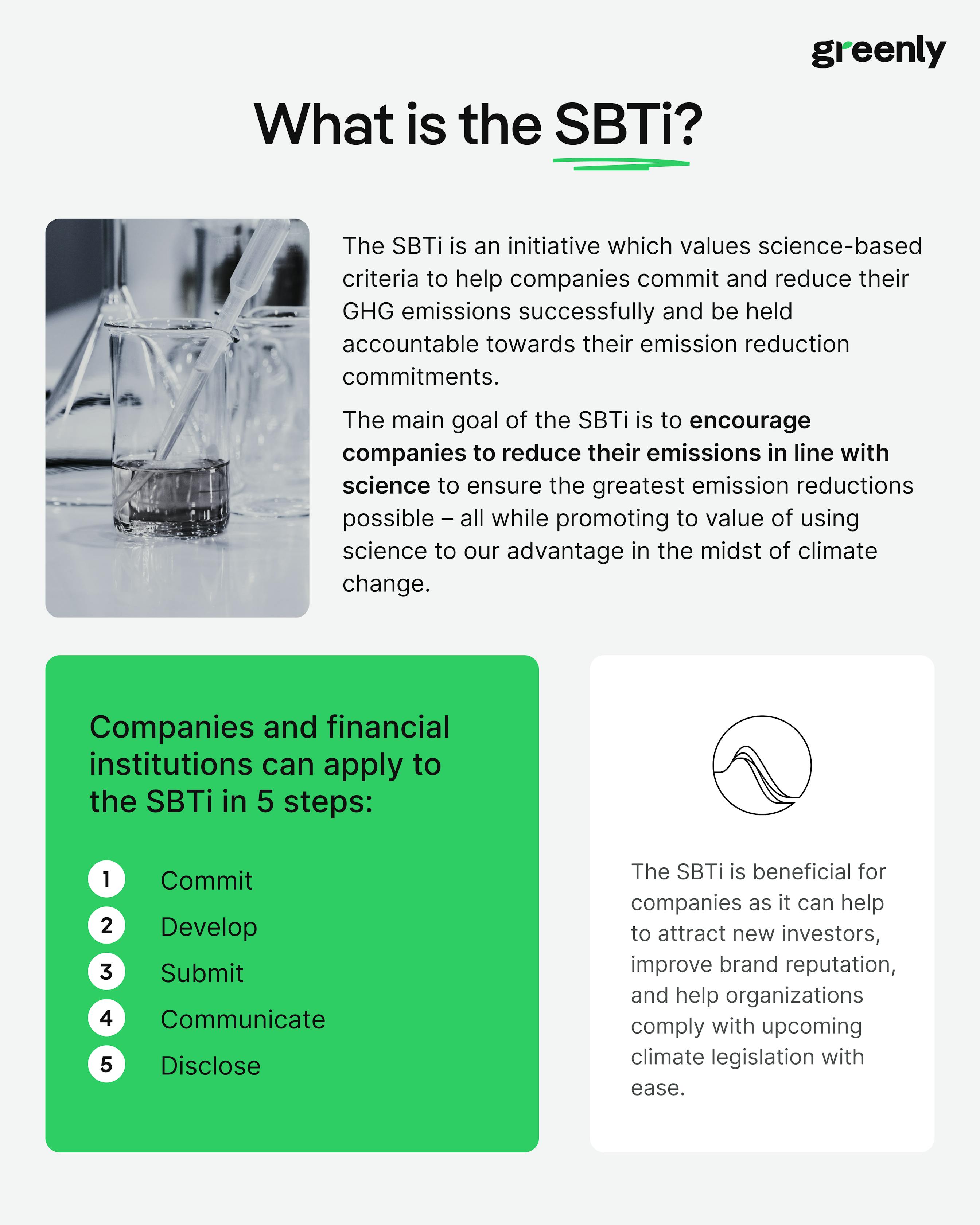
What are the 3 Pillars of Corporate Sustainability?
In this article, we'll explore what the 3 pillars of corporate responsibility are, why they're important, and how businesses can turn them into practical action.
ESG / CSR
Industries



A review of the importance of SBTi
Our favorite companies that make use of SBTi
How Greenly could help in your SBTi journey
Thousands of companies around the world are making an effort to work towards net-zero emissions and decarbonise their business, and one of the best ways to do that is to commit to the SBTi – meaning that companies specialising in SBTi are bound to make more progress in their climate journey than others.
The SBTi can help guide companies to reduce their emissions with the help of science based information to set targets accordingly for all companies specialising in SBTi.
In this article, we’ll review what the SBTi is, the benefits, how the SBTi differs from net-zero, and our top 5 companies specialising in SBTi.
The Science Based Targets initiative, otherwise known as the SBTi, is an organisation which encourages companies to commit to more rigorous climate action by providing them with science-based criteria to help develop effective plans to reduce excessive emissions.
The SBTi is partnered with several other programs of global coalition, such as the CDP, United Nations Global Compact, and the World Resources Institute.

The SBTi works by using scientific data to demonstrate the dire need for companies around the world to effectively reduce their greenhouse gas emissions in line with science to be most effective. In a sense, the SBTi works as a mentor to companies around the world, as their scientific data can help drive others to normalise the use of science-based data to develop relevant, ambitious, and achievable targets.
The main goal of the SBTi is to help businesses around the world work towards net-zero emissions through the help of science-based data.
However, the SBTi also works towards other goals – such as:
Ultimately, the SBTi works to raise awareness regarding the detrimental effects of GHG emissions via the use of science-based data, and subsequently – encourages companies to set new targets in line with the Paris Agreement.

There are numerous benefits to joining the SBTi, such as helping to intrigue stakeholders, reduce operational costs, and ensuring that your company’s current emission reduction targets are as rigorous as possible.
Joining the SBTi demonstrates your companies commitment to reducing emissions, which as a result – could help to attract new customers, investors, and stakeholders to your business.
Here are some more benefits for companies that commit to the SBTi:
Working with the SBTi helps reduce operational costs and encourages companies to implement more energy efficient technologies, improving long-term productivity.
Companies specialising in SBTi can secure more investments by showing awareness of ESG principles, as investors prefer sustainable, low-risk portfolios.
SBTi commitment fosters innovation, pushing companies to create new methods and technologies that support their net-zero ambitions.
By adhering to science-based targets, the SBTi helps companies redefine priorities and modernise outdated business models as climate change progresses.
SBTi-aligned companies are encouraged to utilise emerging technologies to reduce emissions, gaining a competitive edge in innovation and sustainability.
Beyond earning ISO certifications or becoming B Corp certified, SBTi involvement demonstrates science-based integrity and dedication to engaging with stakeholders.
Companies specialising in SBTi will not only benefit from effective emission reductions, but their business will also flourish as a result of being able to comply with environmental regulations easier, re-developing business strategies in line with climate change, and satisfying customers and stakeholders.

The main difference between SBTi and net zero is that they focus on two different areas of fighting against climate change. The SBTi is dedicated towards helping companies to reduce their greenhouse gas emissions, whereas net-zero is an effort to achieve an equal amount of emissions produced with the amount of emissions removed from the atmosphere.
Here is a further breakdown of the difference between the SBTi and net-zero:
SBTi is a collaborative effort between the United Nations Global Compact (UNGC), World Resources Institute (WRI), the World Wide Fund for Nature (WWF) and the CDP – whereas net-zero is not.
The main goal behind the SBTi is to encourage companies to reduce their emissions through the use of science-based targets and mitigate climate change long-term.
Unlike net-zero, SBTi is primarily concerned with reducing emissions before the are emitted into the atmosphere – meaning that efforts such as carbon offsetting or purchasing carbon credits aren’t at the forefront for companies specialising in SBTi.
Net zero, on the other hand, refers to achieving a balance between the amount of greenhouse gas emissions emitted and the amount of emissions being removed.
This means that companies can still emit emissions, and essentially compensate for their excessive carbon footprint with practices such as carbon offsetting or purchasing carbon credits. The SBTi attempts to avoid the need for these kinds of programs in the first place.
Ultimately, the SBTi concentrates on setting science-based emission reduction targets – making it a more specific and numerically, science-based goal as opposed to the general concept of net zero.
However, it is important to note that SBTi and net zero are indeed related to one another – seeing as science-based targets are often required for developing an effective net zero strategy.
The battle cards below will further depict the differences between SBTi and Net Zero:
Essentially, it’s best to think of a bathtub full of water – the SBTi is trying to prevent the bathtub from overflowing in the first place, while net zero approves of using a drain to let some of the water escape. The same principle applies for the SBTi versus net zero, as the SBTi doesn’t want companies to compensate for their emissions – but implement effective actions to reduce them in the first place.

Even though almost 8,000 companies are committed to the SBTi – we’ve rounded up our top five companies specialising in SBTi to provide examples of what a solid commitment to the SBTi program looks like.
Here are our top 5 companies specialising in SBTi:
Infamous for their iPhones, Macbooks, Apple Watches, and more – Apple has been working hard to share their commitment to environmental sustainability in recent years.
One of these goals includes Apple’s efforts to work towards carbon neutrality by 2030 and to encourage their supply chain to switch to the use of renewable energy sources – as one of Apple’s main goals is to optimise the use of renewable energy.
This worldwide and well-known toothpaste brand won’t only polish your teeth – but help to keep the planet cleaner from excess emissions, too.
Colgate is one of the many companies specialising in SBTi, which is exceptionally depicted in their 2025 Sustainability Strategy and their 11 other initiatives to implement greater sustainability. In fact, Colgate has worked closely with the SBTi to curate a strategy to methodically reduce emissions.
Some of Colgate’s current targets with the SBTi include:
Most well known for developing one of the pioneering vaccines to help bring the world out of the depths of the Covid-19 pandemic, Pfizer, the pharmaceutical company based in New York – has also demonstrated that is among the companies specialising in SBTi.
In fact, Pzifer successfully slashed their GHG emissions in half between 2000 and 2014 – reducing their emissions by 20%.
Now, Pfizer is amongst the companies specialising in SBTi – committed towards working towards carbon neutrality by 2030 and encouraging their value chain to do the same by 2025. Pzifer heard about the SBTi from the World Resources Institute, and has continued to collaborate with the SBTi ever since to develop robust emission reduction goals.
Companies specialising in the SBTi, such as Ørsted, are true leaders in the midst of climate change – as this energy company demonstrates to other organisations in the energy sector that it is possible to effectively reduce emissions while still remaining successful.
Did you know that 73% of global emissions are created on behalf of the energy sector?
Ørsted has already made great leaps to secure its place on our top five companies specialising in SBTi – having reduced their scope 1, 2, and 3 emissions a whopping 99% from 2018 levels in addition to reducing 90% of scope 3 emissions from sold products.
Some of Ørsted’s goals validated by the SBTi include:

Our last in our list of top five companies specialising in SBTi is Jacobs, a company determined to reduce the amount of scope 3 emissions created as a result of business travel and commuting.
Jacobs has worked with the SBTi to further develop their efforts to reduce scope 3 emissions created on behalf of employee travel. For example, Jacobs created a carbon pricing effort to help employees weigh their options regarding travel – ultimately encouraging them to work remotely whenever possible.
Under the SBTi, Jacobs plans to further their climate journey by:
If reading this article about the top 5 companies specialising in SBTi has made you interested in reducing your carbon emissions to further fight against climate change – Greenly can help you!
At Greenly we can help you to assess your company’s carbon footprint, and then give you the tools you need to cut down on emissions. We offer a free demo for you to better understand our platform and all that it has to offer – including assistance with boosting supplier engagement, personalized assistance, and new ways to involve your employees.
Click here to learn more about Greenly and how we can help you reduce your carbon footprint.